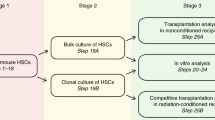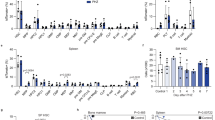Abstract
A human embryonic stem cell (hESC) line that enabled globin-expressing cells to be easily recognized would facilitate optimization of erythroid differentiation in vitro and aid in the identification of hESC-derived erythroid cells in transplanted animals. We describe a genetically modified hESC line, ErythRED, in which expression of RFP, controlled by regulatory sequences from the human β-globin locus control region, is restricted to maturing erythroid cells.
This is a preview of subscription content, access via your institution
Access options
Subscribe to this journal
Receive 12 print issues and online access
$259.00 per year
only $21.58 per issue
Buy this article
- Purchase on Springer Link
- Instant access to full article PDF
Prices may be subject to local taxes which are calculated during checkout



Similar content being viewed by others
References
Lu, S.J. et al. Blood 112, 4475–4484 (2008).
Qiu, C., Olivier, E.N., Velho, M. & Bouhassira, E.E. Blood 111, 2400–2408 (2008).
Stamatoyannopoulos, G. Exp. Hematol. 33, 259–271 (2005).
Li, Q. et al. Blood Cells Mol. Dis. 33, 318–325 (2004).
Costa, M. et al. Nat. Methods 2, 259–260 (2005).
Costa, M. et al. Nat. Protoc. 2, 792–796 (2007).
Ng, E.S., Davis, R.P., Azzola, L., Stanley, E.G. & Elefanty, A.G. Blood 106, 1601–1603 (2005).
Ng, E.S. et al. Nat. Protoc. 3, 768–776 (2008).
Dorn, I. et al. Transfusion 48, 1122–1132 (2008).
Mitjavila-Garcia, M.T. et al. Development 129, 2003–2013 (2002).
Davis, R.P. et al. Blood 111, 1876–1884 (2008).
Kennedy, M., D'Souza, S.L., Lynch-Kattman, M., Schwantz, S. & Keller, G. Blood 109, 2679–2687 (2007).
Tian, X., Woll, P.S., Morris, J.K., Linehan, J.L. & Kaufman, D.S. Stem Cells 24, 1370–1380 (2006).
Ledran, M.H. et al. Cell Stem Cell 3, 85–98 (2008).
Wang, L. et al. J. Exp. Med. 201, 1603–1614 (2005).
Bevis, B.J. & Glick, B.S. Nat. Biotechnol. 20, 83–87 (2002).
Collis, P., Antoniou, M. & Grosveld, F. EMBO J. 9, 233–240 (1990).
Elefanty, A.G., Antoniou, M., Custodio, N., Carmo-Fonseca, M. & Grosveld, F.G. EMBO J. 15, 319–333 (1996).
Talbot, D. et al. Nature 338, 352–355 (1989).
Trudel, M. & Costantini, F. Genes Dev. 1, 954–961 (1987).
Costa, M. et al. Curr. Protoc. Stem Cell Biol. 5, 1C.1.1–1C.1.7 (2008).
Ng, E.S. et al. Curr. Protoc. Stem Cell Biol. 4, 1D.3.1–1D.3.23 (2008).
Vadolas, J. et al. Biochim. Biophys. Acta 1728, 150–162 (2005).
Acknowledgements
This work was supported by research grants from the Australian Stem Cell Centre, the Juvenile Diabetes Research Foundation and the National Health and Medical Research Council of Australia.
Author information
Authors and Affiliations
Contributions
T.H. generated the ErythRED cell line, designed and performed differentiation experiments, flow cytometry and wrote the paper; S.J.M. performed transplantation experiments; E.S.N. designed and performed differentiation experiments and intracellular flow cytometry; J.V. performed HPLC and mass spectrometry experiments; E.G.S. designed experiments, wrote the paper and had final approval of the manuscript; A.G.E. designed and performed experiments, wrote the paper and had final approval of the manuscript.
Corresponding author
Supplementary information
Supplementary Text and Figures
Supplementary Figures 1–5 and Supplementary Table 1 (PDF 640 kb)
Rights and permissions
About this article
Cite this article
Hatzistavrou, T., Micallef, S., Ng, E. et al. ErythRED, a hESC line enabling identification of erythroid cells. Nat Methods 6, 659–662 (2009). https://doi.org/10.1038/nmeth.1364
Received:
Accepted:
Published:
Issue Date:
DOI: https://doi.org/10.1038/nmeth.1364
This article is cited by
-
Basement Membrane Matrix (BME) has Multiple Uses with Stem Cells
Stem Cell Reviews and Reports (2012)
-
Lim1/LIM1 is expressed in developing and adult mouse and human endometrium
Histochemistry and Cell Biology (2012)
-
Albumin and mammalian cell culture: implications for biotechnology applications
Cytotechnology (2010)



